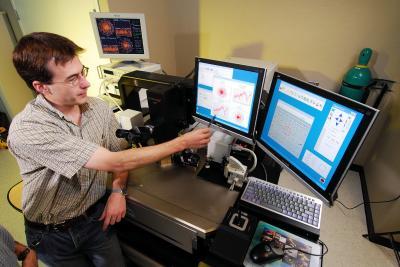New research at the Georgia Institute of Technology could soon make that tangle of wires under desks and in data centers a thing of the past.
Scientists at the Georgia Electronic Design Center (GEDC) at Georgia Tech are investigating the use of extremely high radio frequencies (RF) to achieve broad bandwidth and high data transmission rates over short distances. Stephane Pinel, a research scientist with the Georgia Electronic Design Center, demonstrates gigabit-wireless technology at the group’s Atlanta headquarters.
Stephane Pinel, a research scientist with the Georgia Electronic Design Center, demonstrates gigabit-wireless technology at the group’s Atlanta headquarters.
Credit: Georgia Tech Photo: Gary Meek
Within three years, this “multi-gigabit wireless” approach could result in a bevy of personal area network (PAN) applications, including next generation home multimedia and wireless data connections able to transfer an entire DVD in seconds.
The research focuses on RF frequencies around 60 gigahertz (GHz), which are currently unlicensed -- free for anyone to use -- in the United States. GEDC researchers have already achieved wireless data-transfer rates of 15 gigabits per second (Gbps) at a distance of 1 meter, 10 Gbps at 2 meters and 5 Gbps at 5 meters.
“The goal here is to maximize data throughput to make possible a host of new wireless applications for home and office connectivity,” said Prof. Joy Laskar, GEDC director and lead researcher on the project along with Stephane Pinel.
GEDC’s multi-gigabit wireless research is expected to lend itself to two major types of applications, data and video, said Pinel, a GEDC research scientist.
Very high speed, peer-to-peer data connections could be just around the corner, he believes – available potentially in less than two years.
Devices such as external hard drives, laptop computers, MP-3 players, cell phones, commercial kiosks and others could transfer huge amounts of data in seconds. And data centers could install racks of servers without the customary jumble of wires.
“Our work represents a huge leap in available throughput,” Pinel said. “At 10 Gbps, you could download a DVD from a kiosk to your cell phone in five seconds, or you could quickly synchronize two laptops or two iPods.”
The input-output (I/O) system of current devices cannot approach such speeds.
Moreover, Pinel said, users of multi-gigabit technology could wirelessly connect to any device that currently uses Firewire or USB.
Wireless high-definition video could also be a major application of this technology. Users could keep a DVD player by their side while transmitting wirelessly to a screen 5 or 10 meters away.
Currently, Pinel said, the biggest challenge is to further increase data rates and decrease the already-low power consumption, with a goal to double current transmission rates by next year. The Georgia Tech team is seeking to preserve backward compatibility with the WiFi standard used in most wireless LANs today.
GEDC researchers are pursuing this goal by modifying the system architecture to increase intelligence and effectiveness in the CMOS RF integrated circuits that transmit the data. The researchers are using advanced computer-aided design tools and testbed equipment to recalibrate system models and achieve the desired improvements in speed and functionality.
Investigators are placing special emphasis on implementing an RF concept called single-input-single-output (SISO) / multiple-input-multiple-output (MIMO), which enables ultra-high data throughput. At the same time, they seek to preserve backward compatibility with WLAN 802.11, the WiFi standard used in most wireless LANs today.
“We are pursuing a combination of system design and circuit design, employing both analog and digital techniques,” Pinel said. “It's definitely a very exciting mixed-signal problem that you have to solve.”
Even when sitting on a user’s desk, Pinel stresses, a multi-gigabit wireless system would present no health concerns. For one thing, the transmitted power is extremely low, in the vicinity of 10 milliwatts or less. For another, the 60 GHz frequency is stopped by human skin and cannot penetrate the body.
The fact that multi-gigabit transmission is easily stopped enhances its practicality in an office or apartment setting, he adds. The signals will be blocked by any wall, preventing interference with neighbors’ wireless networks.
Currently there are no world standards in this bandwidth, explains GEDC Director Laskar. To address the situation, representatives of the ECMA International computer-standards organization met at GEDC in February to discuss a new international 60 GHz standard. The three-day gathering included representatives from the Electronics and Telecommunications Research Institute of Korea, GEDC, Intel Corp., IBM Corp., Matsushita Electric Industrial Co. Ltd. (Panasonic), Newlans, Philips Semiconductors, Samsung Electronics Co. Ltd and Samsung Electro-Mechanics Co. Ltd. The ECMA International organization will meet again at GEDC in October to finalize the technical decisions.
The IEEE, the top international association of electrical engineers, is also weighing a 60 GHz standard, to be called 802.15.3C.
Laskar believes that additional applications will emerge as multi-gigabit technology becomes standardized and gains maturity.
“The promise of multi-gigabit wireless is tremendous,” he said. “The combination of short-range functionality and enormous bandwidth makes possible a whole range of consumer and business applications that promise great utility.”
Source: Georgia Institute of Technology Research News